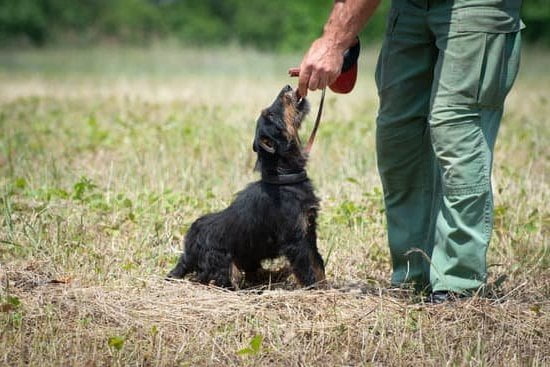When it comes to house training your furry friend, there are various methods to consider. One popular technique that has gained traction in recent years is paper training for dogs. This introductory section aims to provide a comprehensive understanding of what paper training entails, its benefits, and potential drawbacks.
Paper training involves teaching dogs to eliminate on a designated area covered with newspaper or absorbent pads instead of going outdoors or using a traditional litter box. The core concept behind this method is to provide an indoor solution for dogs who may not have immediate access to outdoor spaces or for owners who prefer the convenience of an indoor bathroom option.
As with any training method, paper training has its merits and limitations. On one hand, it can be advantageous for dog owners who live in apartments or areas with limited outdoor access. It also serves as a practical solution during inclement weather conditions when taking dogs outside may be challenging or unsafe. However, some pet parents find that paper training slows down the transition towards outdoor housetraining and can lead to confusion for their pets if not properly implemented.
In the subsequent sections of this article, we will delve deeper into the benefits of paper training while also discussing how to get started with this method, understanding the psychology behind it, troubleshooting common issues, and exploring alternative house training methods. By considering all aspects surrounding paper training, readers can make an informed decision about whether this approach aligns with their specific circumstances and goals in housebreaking their beloved canine companion.
The Benefits of Paper Training Dogs
Paper training dogs can offer several benefits for dog owners, especially those who may have specific circumstances or living situations that make outdoor housetraining challenging. One of the main advantages of paper training is its convenience. This method allows dogs to eliminate indoors on specially designated papers or pads, eliminating the need for constant trips outside, especially in situations where access to a yard or outdoor space is limited.
Additionally, paper training can be particularly beneficial for owners who live in apartments or high-rise buildings without easy access to outdoor areas. It provides a practical solution for ensuring that dogs have a designated spot to relieve themselves without causing inconvenience or potential accidents inside the home.
Another advantage of paper training is its flexibility. It allows pet owners to maintain a consistent routine for their dogs, even during inclement weather conditions or when they are unable to take their pets outside due to illness or other obligations. By providing a reliable method for indoor elimination, paper training ensures that dogs are still able to relieve themselves appropriately even when circumstances prevent them from going outside.
| Benefit | Description |
|---|---|
| Convenience | Eliminates the need for constant trips outside and provides an indoor elimination option. |
| Practicality in Apartments | Suitable for dog owners who live in apartments or lack easy access to outdoor spaces. |
| Flexibility | Allows pet owners to maintain a consistent routine regardless of weather conditions or personal constraints. |
How to Get Started with Paper Training
Paper training is a popular method for house training dogs, especially for those who live in apartments or have limited outdoor space. It involves teaching the dog to eliminate on a designated area covered with absorbent materials, such as newspapers or puppy pads. Here are some step-by-step instructions on how to begin paper training your dog:
- Choose a designated area: Select a specific location in your home where you want your dog to eliminate. This could be a bathroom, laundry room, or any other easily accessible area that can be easily cleaned.
- Set up the paper training area: Place several layers of newspaper or puppy pads on the floor in the chosen area. Make sure to cover enough space to accommodate your dog’s size and minimize accidents outside the designated area.
- Introduce your dog to the paper area: Lead your dog to the paper training area and encourage them to explore it. You can use treats or praise as positive reinforcement to make them associate the area with a reward.
- Establish a routine: Create a consistent schedule for taking your dog to the paper training area. This usually includes after mealtimes, after waking up from sleep, and after playtime sessions. Consistency is key when it comes to successful paper training.
- Reinforce good behavior: Whenever your dog eliminates on the paper, reward them with praise and treats immediately. Positive reinforcement helps reinforce their understanding that eliminating in the designated area is desirable.
- Clean up accidents properly: Accidents are bound to happen during the initial stages of paper training. It is important not to punish or scold your dog for accidents but instead clean them up promptly using an enzymatic cleaner that neutralizes odors and discourages repeat incidents.
By following these steps, you can help set up a solid foundation for successful paper training with your dog. Remember that patience and consistency are essential throughout the training process.
Understanding the Psychology behind Paper Training
Paper training is not just about teaching a dog where to eliminate, but it also involves understanding the psychology behind how dogs learn and adapt to this training method. By comprehending their behavior and motivations, owners can effectively paper train their dogs and set them up for success.
One of the key aspects of paper training is consistency. Dogs are creatures of habit, and they thrive in an environment with predictable routines. Consistency allows them to understand what is expected of them and helps reinforce desired behaviors. When paper training, it is important to establish a designated area for the dog’s elimination needs and consistently bring them to that area every time they show signs of needing to go.
Positive reinforcement is another crucial element when it comes to paper training dogs. By rewarding desired behaviors, such as eliminating on the designated papers, owners can motivate their dogs to repeat those actions in the future. This can be done through verbal praise or treats immediately after the dog eliminates on the papers. The positive association created through rewards helps reinforce the idea that eliminating on the papers is a desirable behavior.
Additionally, understanding a dog’s body language and signals can greatly contribute to successful paper training. Dogs will often exhibit specific signs when they need to eliminate, such as sniffing around or circling a particular area. Observing these cues allows owners to anticipate when their dog needs to go and redirect them towards the designated paper area. Being attentive and responsive to these signals helps create a positive learning experience for both owner and dog.
In summary, grasping the psychology behind paper training can significantly enhance its effectiveness. Consistency, positive reinforcement, and awareness of a dog’s body language are all key components that contribute to successful paper training. By understanding how dogs learn and adapting their approach accordingly, owners can lay a solid foundation for proper elimination habits using this method.
Common Challenges in Paper Training and How to Overcome Them
One of the most common challenges in paper training dogs is accidents outside the designated area. This can happen due to various reasons, such as the dog not understanding the concept of the designated area or confusion between the paper training area and other parts of the house. To overcome this challenge, it is important to reinforce boundaries and consistently redirect the dog to the designated area.
Here are some strategies to tackle accidents outside the designated area during paper training:
- Reinforce Boundaries: Start by creating a clear boundary for where your dog should eliminate by using physical barriers or scent-based markers. For example, you can place baby gates or use a specific type of pee pad with an appealing scent only in the designated area.
- Consistent Redirecting: Whenever you catch your dog about to eliminate outside of the designated area, calmly interrupt them and redirect them back to their designated spot using verbal cues like “go potty” or a specific command you choose. Be patient and consistent with redirections until they understand where they should go.
- Supervision and Timing: Keep a close eye on your dog during their free-roaming time in the house, especially after meals, playtime, or when they show signs of needing to eliminate (sniffing around, circling). Take them immediately to their designated spot if you notice any of these behaviors.
Another challenge that may arise during paper training is regression, where a previously trained dog starts eliminating in inappropriate areas again. This can happen due to changes in routine, stress factors, or health issues. To overcome regression in paper training:
- Re-establish Consistency: Go back to basics and reinforce consistent use of the designated spot for elimination. Be diligent about supervising your dog and providing positive reinforcement when they use it correctly.
- Rule out Health Issues: If there has been a sudden regression in your dog’s behavior, consult with a veterinarian to rule out any underlying health problems that may be causing the regression. Pain or discomfort could interfere with their ability to hold it until reaching the designated area.
- Address Stress Factors: Identify any recent changes or stressors in your dog’s environment and try to address them. Whether it’s a new pet, a change in schedule, or a move to a new home, these factors can contribute to regression. Provide your dog with plenty of mental and physical stimulation, maintain a consistent routine, and create a calm environment.
By implementing these strategies, you can overcome common challenges in paper training and help your dog successfully adapt to this method of house training. Remember that patience, consistency, positive reinforcement, and understanding are key elements in the training process.
Transitioning from Paper Training to Outdoor Housetraining
After successfully paper training your dog, you may decide that it’s time to transition them to outdoor housetraining. This is a natural next step in the training process and allows your dog to learn how to eliminate outside, which is more convenient for both you and your pet. However, it’s important to approach this transition gradually and with patience to ensure a successful outcome.
When to Transition
Before starting the transition process, it’s crucial to assess whether your dog is ready for outdoor housetraining. Signs that your dog is ready include consistently using the designated paper area and showing signs of understanding that eliminating indoors is not acceptable. Additionally, consider factors such as the weather conditions and your own schedule in determining the right time for transitioning.
Gradual Transition
To begin the transition from paper training to outdoor housetraining, start by gradually moving the papers closer to the door leading outside. This helps reinforce the idea of eliminating in a specific area before eventually transitioning entirely outdoors. Another effective approach is gradually reducing the size of the paper area until it becomes small enough for easy transport outside.
Once your dog has adjusted to using the papers near the door, take them outside on a leash multiple times per day, particularly after meals or naps, as these are prime times for elimination. Choose a designated spot in your yard where you want your dog to eliminate consistently. When they do eliminate in that spot, praise them enthusiastically and offer treats as positive reinforcement.
Troubleshooting during Transition
During this transition period, accidents may occur, especially when initially taking your dog outdoors. If accidents happen inside again, avoid punishing or scolding your dog as this can create confusion or anxiety. Instead, refocus on reinforcing good behavior by redirecting them immediately outdoors when you catch them in the act indoors.
It’s also important to be patient and consistent during this transition stage. It may take some time for your dog to fully adapt to eliminating outdoors, so maintain a regular schedule of outdoor trips and reinforce positive behavior with rewards. With time and consistency, your dog will successfully transition from paper training to outdoor housetraining, leading to a well-trained and housebroken pet.
Troubleshooting Paper Training Issues
Common Problems Encountered during Paper Training
While paper training can be an effective way to house train a dog, it is not without its challenges. Understanding the common problems that may arise during the paper training process can help dog owners anticipate and address these issues effectively.
One of the most common problems encountered in paper training is accidents outside of the designated area. Dogs may have accidents on the floor or carpet instead of using the designated papers. This can be frustrating for both dog owners and their pets. Additionally, some dogs may show resistance or reluctance to use the papers altogether, which can hinder progress in their training.
Another challenge is regression in paper training. Even after making good progress, some dogs may start having accidents again after several weeks or months of successful paper training. This regression can occur due to various reasons such as changes in routine, stress, or medical issues.
Troubleshooting Tips and Solutions
Addressing these common problems requires patience, consistency, and appropriate troubleshooting strategies. Here are some tips and solutions for overcoming challenges in paper training:
- Reinforce positive behavior: Use positive reinforcement techniques such as treats, praise, and rewards to encourage your dog to use the designated papers consistently. When your dog successfully eliminates on the papers, immediately reward them with verbal praise and a treat to reinforce this behavior.
- Increase supervision and confinement: Supervising your dog closely during the initial stages of paper training helps prevent accidents outside of the designated area. Consider using baby gates or playpens to confine your dog to a smaller area where they have easy access to the papers.
- Consistently clean accident spots: Make sure to clean any accidents thoroughly with an enzymatic cleaner specifically designed for pet messes. Dogs are more likely to eliminate in places that smell like previous accidents.
- Review your approach: If your dog continues to have consistent accidents outside of the designated area or shows resistance to using the papers, evaluate your training approach. Consider whether you are providing enough opportunities for your dog to eliminate on the papers and adjust your training methods accordingly.
By implementing these troubleshooting tips and solutions, dog owners can effectively address the common challenges encountered during paper training and help their dogs become fully trained to use the designated papers consistently. Remember that each dog is unique, so it may take some trial and error to find what works best for your furry friend.
Paper Training Dogs in Different Living Environments
Paper training dogs can be adapted to suit different living environments, making it a versatile option for owners in various situations. Whether you have a puppy, an adult dog, or live in an apartment, paper training can be modified to accommodate your specific needs.
For puppies, paper training is particularly useful as they may not have the bladder control to hold their eliminations until they can go outside. By providing them with a designated area covered with newspaper or training pads, you can teach them to associate this spot with elimination. As they grow older and gain better control over their bladder and bowel movements, you can gradually transition them to outdoor housetraining.
When it comes to adult dogs who are already accustomed to eliminating outdoors, paper training can still come in handy. In situations where taking them outside consistently is challenging or not feasible, such as during extreme weather conditions or when traveling, having a designated indoor area for them to use can prevent accidents around the house.
Apartment dwellers may find paper training especially beneficial due to limited access or restrictions on outdoor spaces. In high-rise buildings or apartments without immediate access to an outdoor area suitable for dog elimination, paper training allows the owner and the dog to maintain good hygiene and avoid accidents indoors.
While paper training presents benefits for different living environments, it is important to consider that it may not be suitable for all dogs or situations. Factors such as breed and individual temperament may affect how well a dog adapts to this type of training method. Additionally, some dogs may become confused by the presence of both indoor and outdoor elimination options and may require stricter consistency in their housebreaking routine.
Alternative House Training Methods
While paper training is a popular method for house training dogs, it is not the only option available. There are several alternative methods that dog owners may consider when it comes to housetraining their furry companions. Two commonly used alternatives to paper training are crate training and outdoor housetraining. Each method has its own benefits and drawbacks, so it’s essential to understand them before deciding which approach is best for you and your dog.
Crate training is a method where dogs are confined in a crate or kennel for short periods of time when they cannot be supervised. This method leverages the dog’s natural instinct to keep their sleep area clean, encouraging them to hold their bladder and bowel movements until they are let outside.
One advantage of crate training is that it can expedite the housetraining process since dogs quickly learn to associate the crate with their designated elimination area. It also helps prevent accidents inside the house and teaches dogs self-control.
However, there are some potential drawbacks to crate training as well. Some dogs may become anxious or stressed when confined in a crate, especially if they have not been properly introduced to it or if they have had a negative experience in the past. Additionally, crate training requires consistency and diligent scheduling on the part of the owner, as dogs need frequent opportunities to relieve themselves outside of the crate.
Outdoor housetraining, on the other hand, involves teaching dogs to eliminate exclusively outdoors through regular trips outside. This method relies on positive reinforcement and consistency in taking the dog out at specific times during the day. The benefits of outdoor housetraining include allowing dogs to develop healthy elimination habits from an early age, preventing messes inside the home altogether, and providing an opportunity for exercise and stimulation outdoors.
However, outdoor housetraining may not be suitable for all living situations. For example, those living in apartments or high-rise buildings may face challenges getting their dogs outside in a timely manner. Additionally, outdoor housetraining requires a significant time commitment from the owner to ensure the dog is taken out frequently enough. Weather conditions, such as extreme heat or cold, can also pose difficulties for this method.
Conclusion
In conclusion, paper training can be a beneficial method for house training dogs in certain circumstances. It provides convenience and flexibility for dog owners who may not have immediate access to outdoor areas or have limited mobility. Paper training is also particularly useful for apartment dwellers or those living in high-rise buildings where access to outdoor spaces may be limited or inconvenient.
However, it is important to recognize that paper training is not a one-size-fits-all solution. It requires consistent effort, patience, and positive reinforcement to effectively train a dog to use designated areas indoors for elimination. It is crucial to understand the psychology behind paper training and how dogs learn and adapt to this method. Consistency in training methods and providing clear cues can significantly contribute to success in paper training.
While paper training might be advantageous in specific scenarios, it is essential to consider alternative house training methods and their pros and cons. Crate training or outdoor housetraining may be more suitable for some dog owners depending on their living situation and lifestyle. Each method has its own benefits and limitations, so it is important to evaluate your specific circumstances before deciding which approach will work best for you and your furry companion.
Ultimately, the goal of any house training method is to establish good habits that promote cleanliness and proper elimination behavior in dogs. If you decide that paper training aligns with your circumstances and preferences, make sure to follow the step-by-step instructions provided in this article as well as troubleshoot any challenges that may arise along the way.
With consistency, patience, and positive reinforcement, you can successfully paper train your dog and create a harmonious living environment for both you and your beloved pet.
Frequently Asked Questions
What does paper trained mean?
Paper trained refers to a method of house-training a dog or puppy using newspaper or puppy pads as their designated bathroom area. The goal is to teach the dog to eliminate on these papers instead of soiling other areas of the house.
Through consistent training and positive reinforcement, the dog learns to associate the specific area covered with newspaper as an acceptable place for them to relieve themselves.
How long does it take to paper train a dog?
The time it takes to paper train a dog can vary depending on several factors, such as the individual dog’s age, temperament, and learning capabilities, as well as the consistency and effectiveness of the training methods used. Generally, it can take anywhere from a few weeks to several months for a dog to become fully paper trained.
Consistency in routine and reinforcement of desired behavior are key components in achieving successful results.
How long does it take to paper train a puppy?
Paper training a puppy usually takes longer than training an adult dog due to their younger age and limited bladder control. Puppies have developing bodies and may need more frequent bathroom breaks compared to adult dogs. On average, it can take around 4-6 months to paper train a puppy successfully.
However, this timeline can vary based on factors like breed, individual characteristics, and how consistently training is implemented. Being patient, encouraging positive habits, and maintaining a regular schedule for potty breaks are essential for effectively paper training a puppy.

Welcome to the blog! I am a professional dog trainer and have been working with dogs for many years. In this blog, I will be discussing various topics related to dog training, including tips, tricks, and advice. I hope you find this information helpful and informative. Thanks for reading!





